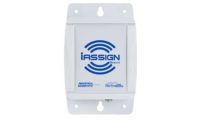From Industrial Scientific
Top 3 ways iAssign beacons improve workplace safety

From Industrial Scientific:
What are Bluetooth beacons?
Most people today are using Bluetooth technology in their daily lives. Bluetooth (also known as Bluetooth Low Energy or BLE) is embedded in many of our favorite consumer products and does a great job of making our lives more convenient and efficient. It’s likely that your car, computer, smartphone, and entertainment center all employ Bluetooth technology to wirelessly transmit information. Just walking around town, you’ll notice people talking on headsets, listening to music as they exercise, or checking their daily fitness stats on their wearable fitness tracker, all using Bluetooth. It’s simply a part of our everyday routines.
While you are likely familiar with the devices mentioned above, you may not be quite as familiar with Bluetooth beacons. In simple terms, a beacon is a device that continuously transmits a radio signal that identifies itself based on your location. Beacons are being used at ballparks, malls, and museums and provide useful information to patrons in near proximity. Using an app on your smartphone, these beacons can help direct you to certain stores, provide coupons and special deals, and even give you links to more information on the piece of artwork you’ve been admiring.
Bluetooth and Bluetooth beacons can make our personal lives easier and more enjoyable, but how can this technology be used in our work lives? Specifically, how can beacons be paired with gas detectors to keep workers safe from dangers on the job? Read on to learn about the top 3 industrial uses for Bluetooth beacons.
1. Beacons tell you where an incident happened
Knowing where your people were, especially when there was potential for a safety incident, is invaluable in the quest for eliminating death on the job. Beacons provide a cost-effective and scalable solution. Beacons, while simple to install, allow for a wide range in location monitoring, from 100 feet all the way down to a few feet, depending on the application.
Much like the retail application with your phone, a gas detector will listen to the broadcasts from beacons in the area and use those messages to determine where the beacon is located. Now the gas monitor data will be tagged with a location. Here is a comparison of gas detector data with and without information from Industrial Scientific’s iAssign™ Beacons.
What a difference knowing the location makes! You can now see that Chris K. was exposed to a high H2S alarm for 3 minutes at Storage Tank A, making it much easier to investigate the area, determine the root cause of the exposure, and eliminate the hazard before a potentially tragic incident occurs.
2. Beacons notify workers when they have entered restricted areas
In addition to beacons helping us know where alarms are occurring within a facility, they can also be valuable in ensuring that untrained personnel are not gaining access to areas of the facility where they should not be. Since beacons know if an operator with a monitor is within a specified distance of it, it can send the monitor into alarm if an operator without sufficient permission has entered a restricted area. This Proximity Alarm feature ensures that everyone within an area has the proper training and is authorized to be in that area. Beacons can also be used to activate or deactivate particular instrument functions, control settings, or send a message that other particular safety equipment is required to be used in a given area.
3. Beacons can be deployed almost anywhere
Beacons can be deployed and function almost anywhere—inside or out, hazardous location or safe zone. Beacons are low cost, rated for any Class I area, are weather resistant, and operate up to four years on two AA batteries. They can provide location accuracy down to 1 meter, depending on the settings and number of beacons deployed, without the need for a GPS receiver or a complex triangulation algorithm and other costly wireless infrastructure.
Data that tells you the “what” and the “when” without telling you the “where” leaves you wandering in the dark and unable to determine the why of any event. Beaconing shines light on your data and allows you to recognize the full value of the data that your gas monitoring program can provide.
Want to learn more about the iAssign™ Beacon from Industrial Scientific? Click here to visit the iAssign web page.
Looking for a reprint of this article?
From high-res PDFs to custom plaques, order your copy today!







